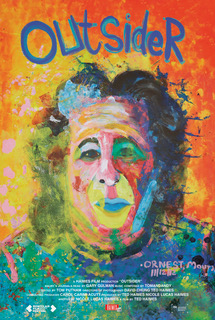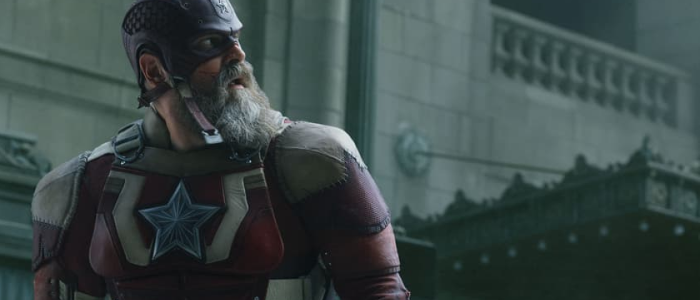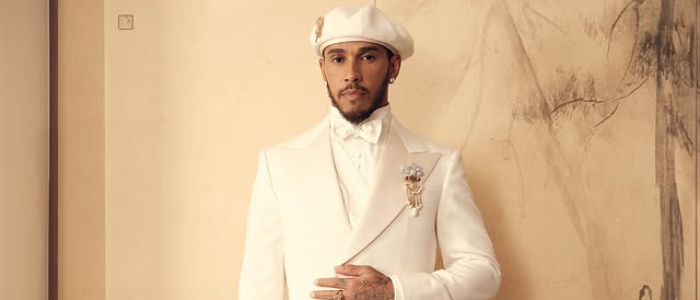Poster for the documentary “Outsider.” Photo by Zi Zhang The term “outsider artist” generally refers to someone who, without formal training, creates a body of artistic work. Usually, their works aren’t shown publicly until some unusual event — oftentimes their death — leaves others to discover the idiosyncratic, untutored, sometimes jaw-dropping collection they’ve left behind.
“Outsider,” the new documentary from filmmaker Ted Haimes screening on Sunday at PMA Films , is about an outsider artist named Maury Ornest. Ornest, before his 2018 death from heart failure at the age of 58, left behind a trove of vibrant, fascinating paintings that filled every room of his modest Los Angeles home. The discovery and subsequent quest to celebrate Ornest’s art by his sister Laura forms the narrative of the 40-minute “Outsider.

” Bright, bold planes of primary colors form portraits, fantastical airborne vehicles, and bustling, eccentric landscapes, many peppered with images of baseballs, often sporting toothy smiles. In “Outsider,” Maury’s voice, culled from the hundreds of similarly teeming journals also left behind after his death, emerges thanks to a voiceover by stand-up comic Gary Gulman, Maury’s tumble of expressionistic, sometimes frantic prose juxtaposed against the sunny, cartoonish world of his art. The thing is, Maury Ornest the outsider artist started out as the ultimate insider before what his sister describes as a psychotic break increasingly pulled him away from what had been a charmed and successful life.
Born into a wealthy family obsessed with baseball (Maury and Laura’s father founded a triple-A team in Vancouver), the handsome and charming Maury excelled in his beloved sport, eventually making it to the minors himself and showing enough promise at the plate to suggest a real future in the bigs. Maury Ornest Photo courtesy of Laura Ornest But Maury Ornest’s baseball dreams ended with a headlong collision with an unpadded cement outfield wall in 1982. Soon after, as Laura recounts, she received an alarming phone call from her brother where he warned, “Helicopters are flying over my duplex, and the Nazis are coming.
” Says Laura of what was eventually diagnosed as her once outgoing brother’s schizoaffective disorder, “It was baffling, and scary.” As Maury withdrew from his once close-knit family and friends thanks to the wild mood swings, paranoia and delusions that sometimes caused him to lash out with frightening unpredictability, Laura, like so many whose loved ones are touched by mental illness, tried to keep their connection alive. She remembers the good times, as when Maury doted on her young son Harrison, as well as the bad, as when a delusional episode saw Maury attack their brother, leading to a wrenching separation.
“It was the 1980s,” says Laura, “We didn’t know anyone who’d experienced this, and nobody talked much about mental illness then. It broke my heart what was happening to Maury, but it was lonely for us, too.” Noting the inevitable question raised by the film, Laura dismisses the idea that Maury’s fateful concussion contributed to his encroaching condition, noting how mental illness had claimed an uncle through suicide.
Even so, she admits, she and her family were utterly unprepared to cope with their golden brother’s descent. “Outsider” represents Laura Ornest’s attempt to reclaim her connection to her troubled brother, her discovery and celebration of the more than 1,400 paintings made by Maury during his years of often manic, lonely struggle. It’s her way to both bring attention to the issue of mental illness and to show the world the bright and brilliant artistic soul that he discovered within himself.
“Maury was not an artist growing up — he was a jock, a slugger,” reminisces Laura, “He was silly and funny, with a gift for mimicry.” It’s that spirit that Laura says she hopes viewers of both “Outsider” and her brother’s artworks will take away from her years-long mission. She also credits his lifelong love of baseball for buoying her brother during his darkest — and most creative — times.
One of Maury Ornest’s artworks. A documentary about him, called “Outsider,” will screen at the Portland Museum of Art. Photo courtesy of Laura Ornest “Maury painted like he played, with everything he had,” Laura Ornest says, referencing the exuberant nature of much of his art.
“I wonder if his attitude toward baseball plus Maury’s own positive personality helped him. That spirit of ‘never give up,’ of competition.” Indeed, in several of his paintings, the motto “Keep drawing” recurs.
You can practically imagine the strapping slugger similarly talking himself into belting his next home run, that can-do inner monologue all baseball players develop in a sport where failure is your constant companion. For Laura, the showings of “Outsider” across the country and back here in Maine (she and her husband live half the year in Woolwich) are a celebration — and a message to others. “I’m honored that [PMA Films programmer] Christopher Gray chose to include us,” says Laura.
She also credits Haimes and Gulman (whose stand-up and film “The Great Depresh” has bracingly addressed his own mental health struggles) for helping her bring her brother’s story to life. “Our goal with the film is to inspire conversation, awareness, and compassion with those facing mental illness (in themselves or their loved ones), and to show that you are not alone. And that art has the power to heal.
” “Outsider” screens at 3 p.m. Sunday at PMA Films .
The film will be followed by a panel discussion led by Laura Ornest and Maine-based mental health professionals Dr. Cynthia Sortwell and Sarah Balascio. In addition, “Outsider” will air on Maine Public TV on at 9 p.
m Monday and May 27. To learn more about Maury Ornest’s life and art (and to purchase paintings — all proceeds go to charity), visit www.mauryornest.
com . We believe it’s important to offer commenting on certain stories as a benefit to our readers. At its best, our comments sections can be a productive platform for readers to engage with our journalism, offer thoughts on coverage and issues, and drive conversation in a respectful, solutions-based way.
It’s a form of open discourse that can be useful to our community, public officials, journalists and others. Read more..
. We do not enable comments on everything — exceptions include most crime stories, and coverage involving personal tragedy or sensitive issues that invite personal attacks instead of thoughtful discussion. For those stories that we do enable discussion, our system may hold up comments pending the approval of a moderator for several reasons, including possible violation of our guidelines.
As the Maine Trust’s digital team reviews these comments, we ask for patience. Comments are managed by our staff during regular business hours Monday through Friday and limited hours on Saturday and Sunday. Comments held for moderation outside of those hours may take longer to approve.
By joining the conversation, you are agreeing to our commenting policy and terms of use . More information is found on our FAQs . You can modify your screen name here .
Show less Please sign into your Press Herald account to participate in conversations below. If you do not have an account, you can register or subscribe . Questions? Please see our FAQs .
Your commenting screen name has been updated. Send questions/comments to the editors..
Entertainment

‘Outsider’ documentary brings an artist’s mental struggles — and talent — into focus

The film about outsider artist Maury Ornest, who died in 2018, paints a portrait of 'the ultimate insider' whose career-ending injury changed his life.















